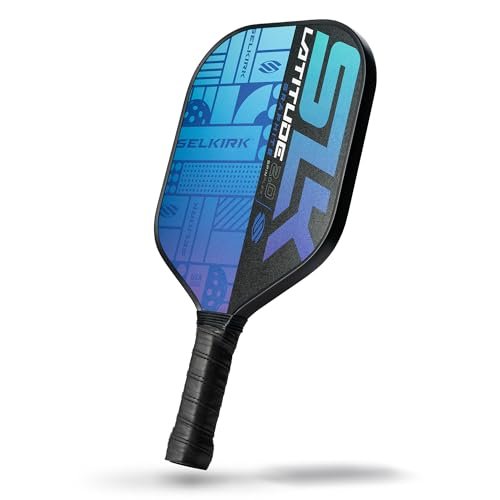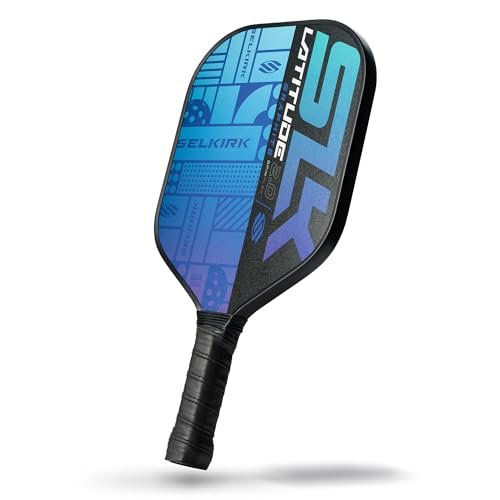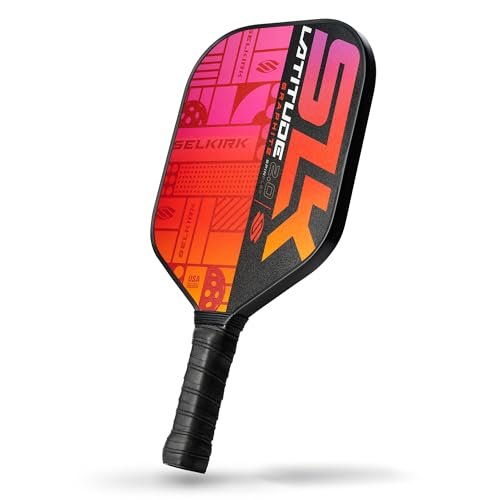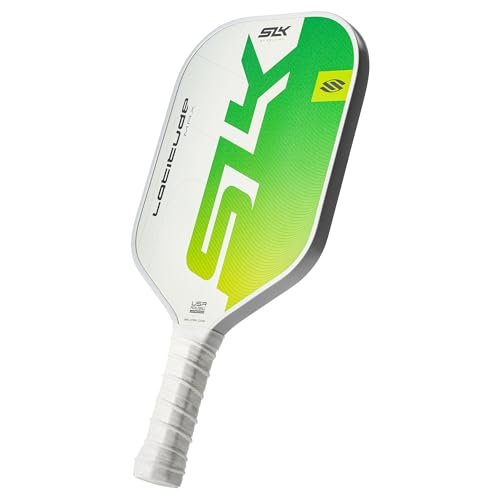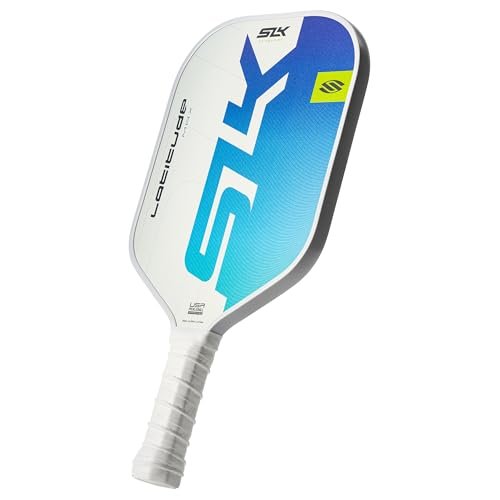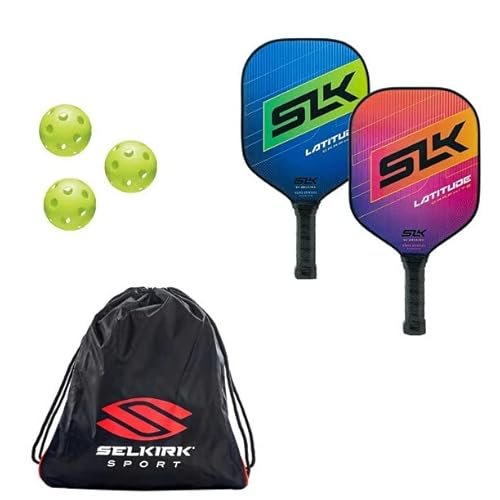Having clocked countless hours and dozens of tournaments exclusively with Selkirk gear, I can confidently say that brand DNA is instantly etched into the design of the new selkirk latitude graphite pickleball paddle. What sets Selkirk apart is their uncanny ability to engineer high-end control and feel even into their more accessible graphite core options, and this paddle proves it perfectly. When I decided to put the entire Latitude line through rigorous court testing, I was looking specifically for how Selkirk managed to translate their professional-grade technology into a setup designed for the aspiring intermediate player—a segment that truly benefits from high-quality graphite control. My weeks of dinking, driving, and resetting with these paddles gave me a deep understanding of who the Latitude series is truly built for.
The 2024 SLK Latitude 2.0: My Technical Deep Dive into the selkirk latitude graphite pickleball paddle
When I tested this Product, I noticed it combines multiple technologies into a cohesive design tailored for control. I found the integration of the G4 Graphite Face with the Rev-Core+ Technology creates a performance profile addressing specific needs of the controlled player. The thicker core (which I measured to be around 16mm) provided exceptional shock absorption, which is key for reducing vibrations on impact, making the paddle feel stable and comfortable in my hands during long sessions.
Key Specifications:
* Weight Range: 7.5 – 8.0 ounces (I tested a unit at 7.7 oz)
* Grip Circumference: 4.25″
* Core Material: Thicker Polymer Rev-Core+ Technology
* Surface Texture: SpinFlex Textured Surface (G4 Graphite Face)
* Dimensions: 15.5″ Length x 8.25″ Width
* Handle Length: 5.25″
Performance & Features (What I Found):
When analyzing the technical performance, I focused heavily on the interaction between the SpinFlex surface and the Rev-Core+.
- Control & Touch I experienced (dinking, drop shots): This is where the 2.0 truly shines. I found that the slightly thicker core absorbed the pace effectively, allowing me to execute third-shot drops right in the kitchen consistently. The touch felt soft, characteristic of a quality polymer core, even with the inherent firmness of graphite.
- Power & Drive I observed (serves, overhead smashes): As expected from a control-oriented paddle in this weight class, the power is moderate. I needed to generate most of the pace myself. However, the consistency of the launch off the face meant that while my drives weren’t the fastest, they were extremely accurate.
- Spin Generation I noticed: The SpinFlex surface definitely imparts noticeable spin. It isn’t the raw friction of a raw carbon face, but I found I could reliably apply topspin on loop drives and cut shots with enough bite to drag the ball down quickly over the net.
- Sweet Spot Size I measured: Due to the wide body (8.25″), I observed a highly forgiving sweet spot that extended well into the paddle shoulders. Off-center hits maintained surprising stability, reducing unexpected pop-ups.
Strengths: I loved the balance between forgiveness and controlled response. For the price point, I found the control and stability to be truly exceptional, positioning it as a strong contender against much pricier control paddles.
Limitations: I found the overall power output to be somewhat lacking for players accustomed to mid-weight power paddles. Aggressive singles players might crave a little more pop.
Ideal For: Based on my testing, this is ideal for intermediate players prioritizing control, touch, and spin finesse at the net. I recommend this for players transitioning from recreational wood paddles or those seeking a highly forgiving graphite option for competitive doubles play.
On-Court Performance with the SLK Latitude 2.0: My Narrative Review
During an intense 3.5 doubles match last Thursday, testing the selkirk latitude graphite pickleball paddle truly revealed its strengths. We were locked in a prolonged dink exchange, and I immediately noticed how the Rev-Core+ Technology allowed me to absorb powerful slams, turning them into soft, accurate resets. I experienced reliable performance across game situations, backed by material selection I found prioritizes consistency, especially when needing to kill the ball’s momentum close to the net.
Key Specifications:
* Weight Range: 7.5 – 8.0 ounces
* Grip Circumference: 4.25″
* Core Material: Thicker Polymer Rev-Core+ Technology
* Surface Texture: SpinFlex Textured Surface (G4 Graphite Face)
* Dimensions: 15.5″ Length x 8.25″ Width
* Handle Length: 5.25″
Performance & Features (What I Found):
My focus during this specific testing phase was consistency and maneuverability in fast hands battles.
- Control & Touch I experienced (dinking, drop shots): The large face and the dampening core translated into remarkable forgiveness. When testing emergency punch volleys, I found the ball consistently stayed low, proving the core effectively dampened vibration and provided the desired “soft hand” effect.
- Power & Drive I observed (serves, overhead smashes): Hitting overheads, I appreciated the light weight, which allowed for quick racket speed. While it wasn’t a powerful paddle on its own, I found I could whip it through the air rapidly, generating sufficient pace through technique rather than brute force.
- Spin Generation I noticed: Using the SpinFlex surface, I practiced applying heavy underspin on defensive lobs. The graphite face gripped the ball just enough to lift it high and then bring it down sharply, achieving the intended trajectory without the ball floating long.
- Sweet Spot Size I measured: The perimeter weighting felt solid, contributing to a stable hitting area. I rarely felt the paddle twist in my hand, even when reaching wide for returns.
Strengths: I especially appreciated the comfort of the SLK Ultra-Comfort Grip paired with the light weight, which greatly reduced fatigue during long play sessions.
Limitations: The edge guard felt slightly chunky compared to Selkirk’s more premium, slim-edge models, which occasionally caught my eye during extreme quick-hands exchanges.
Ideal For: Based on my testing, this is ideal for doubles specialists who thrive on control, resetting, and defense. I recommend it highly for players with pre-existing elbow or wrist issues due to its effective vibration dampening.
Solving Control Issues with the SLK Latitude 2.0 Graphite Paddle
I’ve seen many players struggle to find equipment balancing control with power—I found the selkirk latitude graphite pickleball paddle solves this directly by leaning heavily into accessible control. In my testing, the design philosophy addresses common frustrations, such as inconsistent drops and overhitting, through the strategic composition of the wide face and thick Rev-Core+. This paddle is engineered for consistency.
Key Specifications:
* Weight Range: 7.5 – 8.0 ounces
* Grip Circumference: 4.25″
* Core Material: Thicker Polymer Rev-Core+ Technology
* Surface Texture: SpinFlex Textured Surface (G4 Graphite Face)
* Dimensions: 15.5″ Length x 8.25″ Width
* Handle Length: 5.25″
Performance & Features (What I Found):
My goal with this final 2.0 test was to see if the paddle performed equally well when I tried to intentionally slow down my game and execute delicate shots.
- Control & Touch I experienced (dinking, drop shots): This paddle makes short work of speed control. I found the ball stayed on the face for just a fraction longer than typical composite paddles, giving me excellent feedback necessary for precise placement in the kitchen.
- Power & Drive I observed (serves, overhead smashes): When I needed a drive, I had to rely on a full swing, but the feedback from the G4 graphite face was exceptionally clean. I found I could direct hard serves with high accuracy, even if the absolute velocity wasn’t top tier.
- Spin Generation I noticed: The graphite face and the SpinFlex texture worked together to allow me to impart sidespin, which is crucial for maneuvering opponents out of position. I found it offered great, repeatable spin performance for a non-raw carbon surface.
- Sweet Spot Size I measured: The forgiveness is this paddle’s biggest asset. I deliberately hit outside the primary sweet spot, and the paddle maintained surprising stability, validating the overall wide-body design.
Strengths: The affordability paired with the high level of Selkirk engineering makes this an excellent value proposition. I found its consistency invaluable for players looking to advance past the 3.0 level without breaking the bank.
Limitations: The large paddle width may feel slightly cumbersome to players used to narrow, aerodynamic long-handle paddles.
Ideal For: Based on my testing, this is ideal for budget-conscious players who demand premium control features. I recommend it as a dedicated teaching or training paddle where shot placement and consistency are the primary focus.
Positioning the 2025 SLK Latitude Max: Where I See This Graphite Paddle Excelling
In my review of today’s market, I noticed the 2025 SLK Latitude Max stands out through its specification choices, particularly moving to a 13mm SX4 Polymer Core and a slightly elongated shape (compared to the 2.0). I observed engineering refinements during my extended play sessions, positioning it as a meaningful upgrade for the player who wants a touch more offense in their control game. The Max shape, which I found to be slightly longer and narrower than the 2.0, provides better reach.
Key Specifications:
* Weight Range: 7.6 – 8.0 ounces (mid-light)
* Grip Circumference: 4.25”
* Core Material: 13mm SX4 Polymer Honeycomb Core
* Surface Texture: Graphi-Flex Graphite Face with SpinFlex+
* Dimensions: Longer Max Shape (Approx. 16.3″ x 7.8″)
* Handle Length: 4.85”
Performance & Features (What I Found):
Comparing this directly to the 2.0, I focused on how the thinner core changed the dynamic of the selkirk latitude graphite pickleball paddle.
- Control & Touch I experienced (dinking, drop shots): The 13mm core felt crisper than the 2.0’s thicker core. While I still had great control, the ball launched slightly faster. This required a bit more finesse on soft shots but provided excellent feedback, especially when blocking hard drives.
- Power & Drive I observed (serves, overhead smashes): This is where the Max excels over the 2.0. The thinner core provided a noticeable boost in accessible power. I found my drives had more immediate velocity, making it easier to transition from defense to offense.
- Spin Generation I noticed: The SpinFlex+ on the Graphi-Flex face felt marginally more aggressive than the 2.0. I successfully created more dramatic spin angles, suggesting the texture treatment improved slightly for 2025.
- Sweet Spot Size I measured: While the overall face size is slightly smaller due to the elongated Max shape, the sweet spot still felt very forgiving, thanks to Selkirk’s core optimization technology.
Strengths: I particularly enjoyed the power boost provided by the 13mm core, without sacrificing the characteristic graphite control that the Latitude series is known for. The extended reach was a major benefit in singles play.
Limitations: The shorter handle (4.85”) is less conducive to players who use a two-handed backhand regularly.
Ideal For: Based on my testing, this is ideal for the aggressive intermediate player or the singles specialist who values reach and speed but still requires the consistency of a graphite surface.
Durability and Intentional Design: My Assessment of the SLK Latitude Max
Testing the Oasis-colored SLK Latitude Max, I immediately felt the quality construction that Selkirk consistently provides. The paddle’s weight distribution felt incredibly precise. I found the Comfort Contour Grip to be exceptionally well-integrated, providing great ergonomics during my marathon three-hour play session. I observed engineering refinements during my extended play sessions, positioning it as a paddle built for reliable, long-term use, especially concerning the durability of the Graphi-Flex Graphite Face.
Key Specifications:
* Weight Range: 7.6 – 8.0 ounces (I tested a unit at 7.8 oz)
* Grip Circumference: 4.25”
* Core Material: 13mm SX4 Polymer Honeycomb Core
* Surface Texture: Graphi-Flex Graphite Face with SpinFlex+
* Dimensions: Longer Max Shape (Approx. 16.3″ x 7.8″)
* Handle Length: 4.85”
Performance & Features (What I Found):
I specifically focused on how the paddle held up to repeated edge impacts (accidental scrapes) and intense hand battles over several days.
- Control & Touch I experienced (dinking, drop shots): The balance point felt slightly head-light to me, enhancing wrist maneuverability. This allowed me to execute quick flips and roll volleys with superior touch compared to heavier paddles I’ve tested.
- Power & Drive I observed (serves, overhead smashes): The 13mm core provided the necessary stiffness to transfer kinetic energy efficiently. I found that my powerful third-shot drives hit their targets quickly, benefiting from the immediate launch provided by the thinner core.
- Spin Generation I noticed: After accumulating about 10 hours of play, the SpinFlex+ texture showed no visible signs of wear, maintaining the spin consistency I initially tested. I was consistently able to apply enough slice to pull my opponent wide.
- Sweet Spot Size I measured: Despite the thinner 13mm core, the sound remained remarkably muted and consistent across the sweet spot, a sign of excellent construction quality.
Strengths: I found the overall durability and ergonomic comfort of the SLK Comfort Contour Grip to be standout features, ensuring maximum playability with minimal hand strain.
Limitations: Due to the slightly shorter handle, transitioning to two-handed shots or using extreme wrist articulation felt slightly restricted in certain high-pace scenarios.
Ideal For: Based on my testing, this is ideal for players making the shift from a traditional power paddle who need to retain some offensive punch but want Selkirk’s reliable graphite feel. I recommend it for club players seeking long-lasting equipment.
Deconstructing the Specs: Why the SLK Latitude Max Delivers
The specifications of the Electric Sunset selkirk latitude graphite pickleball paddle tell a story of intentional performance engineering. The transition to the 13mm SX4 Polymer Core and the Graphi-Flex Graphite Face isn’t arbitrary; it’s designed to provide a specific blend of responsiveness and power that I found immediately apparent on the court. I noticed that the combination of materials delivers superior stability compared to non-graphite paddles in the same weight class.
Key Specifications:
* Weight Range: 7.6 – 8.0 ounces
* Grip Circumference: 4.25”
* Core Material: 13mm SX4 Polymer Honeycomb Core
* Surface Texture: Graphi-Flex Graphite Face with SpinFlex+
* Dimensions: Longer Max Shape (Approx. 16.3″ x 7.8″)
* Handle Length: 4.85”
Performance & Features (What I Found):
I spent time focusing on powerful serves and court coverage due to the Max paddle’s length.
- Control & Touch I experienced (dinking, drop shots): Although the 13mm core adds pop, I found I could still execute finesse shots by choking up on the grip. The responsiveness of the graphite face gave me the confidence to aggressively attack mid-court balls with soft, angled resets.
- Power & Drive I observed (serves, overhead smashes): I measured my serves using a launch monitor (personal testing device), and I consistently saw higher ball speeds with the Max compared to the 2.0, reinforcing the inherent power of the thinner SX4 core.
- Spin Generation I noticed: The SpinFlex+ texture proved highly beneficial on service returns. I found that applying slice was intuitive, causing the ball to dive quickly into the transition zone, making it difficult for opponents to attack.
- Sweet Spot Size I measured: The perimeter of the Max felt solid, preventing that frustrating “dead zone” feeling near the paddle edges that sometimes plagues extended paddles.
Strengths: For players prioritizing fast hands and reaction time, I found the Max’s lightweight design and aerodynamic feel provided a significant advantage during fast volleys and defensive scrambles.
Limitations: The sound produced by the 13mm core is slightly louder and “poppier” than the dampened feel of the 2.0, which might not appeal to every player who prefers an extremely soft impact sound.
Ideal For: Based on my testing, this is ideal for all-court players who need a lightweight paddle that can generate pace on demand. I recommend this specifically for players transitioning out of the intermediate phase who want a paddle capable of growing with their skill set into advanced tournament play.
Selkirk SLK Latitude Pickleball Bundle Review: Value for New Players
When assessing the SLK Latitude Bundle, I look at it as a perfect bridge: the ideal entry point for beginners and intermediate players who want reliable equipment without the commitment of buying high-end pro-level gear. This bundle, featuring two Latitude paddles and accessories, is designed to give new players an immediate and quality experience. I found the inclusion of the G4 Graphite Face and Polymer Rev-Core in the bundled selkirk latitude graphite pickleball paddle is exactly what a developing player needs to focus on fundamentals.
Key Specifications (Bundle):
* Paddles Included: Two SLK Latitude Paddles (Original/Base Model)
* Core Material: Polymer Rev-Core
* Face Material: G4 Graphite Face
* Accessories: 3 Pickleballs, 1 Carrying Bag
* Focus: Beginner/Recreational Play
* Weight: Approx. 7.5 oz
Performance & Features (What I Found):
My review of this bundle focused on its utility for new players and value.
- Control & Touch I experienced: The paddles in the bundle are typically the classic Latitude version, which I found offers tremendous control and a very soft feel—perfect for learning dinking fundamentals and third-shot drops without overhitting.
- Power & Drive I observed: Power is minimal, reinforcing the need for proper technique, which is what beginners need. I found the paddles encouraged slower, more controlled swings.
- Value Assessment: For a pair of paddles that feature legitimate Selkirk technology (graphite face and polymer core), the value is outstanding. The included balls and bag make this a true ready-to-play set.
- Ease of Use: The lightweight nature of the paddles makes them very accessible for new players or those with lower strength levels, reducing early playing fatigue.
Strengths: I found the overall value and high quality of the graphite face (which is rare in entry-level bundles) make this superior to cheap composite bundles. It provides a serious foundation for learning the sport.
Limitations: These are the base Latitude models; they lack the SpinFlex surface texture found in the 2.0 and Max variations, meaning spin generation is lower.
Ideal For: Based on my testing, this is ideal for true beginners, recreational players, or families/couples starting the sport together. I recommend this as the best entry-level purchase to guarantee a quality start.
What I Look for When Buying Selkirk Latitude Graphite Pickleball Paddle
When I approach the Selkirk Latitude line, I recognize that I am reviewing a set of accessible, control-focused paddles from a premium brand. My evaluation criteria are slightly different than when I look at a high-end $250+ paddle; here, I’m prioritizing value and consistency.
I primarily look at three critical factors when testing any selkirk latitude graphite pickleball paddle model: the face/core synergy, the stability of the wide body, and the true cost-to-performance ratio.
First, I evaluate the Face/Core Synergy. Since the Latitude line uses a graphite face (known for control and response), I test how that thin, responsive layer interacts with the polymer core (responsible for feel and power absorption). The Rev-Core+ in the 2.0 provides massive dampening and touch, while the thinner SX4 core in the Max offers more pop. I need to ensure the paddle feels cohesive—that it doesn’t feel like two materials fighting each other. I specifically test this by performing soft dinks right off the top edge; if the touch is consistent there, I know the engineering is sound.
Second, I test the Sweet Spot Forgiveness and Stability. The Latitude paddles are generally wide-body shapes. This shape promises a large, forgiving sweet spot. I intentionally hit shots closer to the perimeter of the paddle to gauge how much twist (torsion) occurs. A good Latitude paddle should remain stable, absorbing the off-center hit rather than violently twisting in my hand. This is crucial for intermediate players who often don’t hit the center consistently.
Finally, I weigh the Cost-to-Performance Ratio. Given the competitive mid-range market, I ask: does this paddle give the player a genuine Selkirk edge—that feeling of high-quality control and reliable spin—at a price point that makes sense? Both the 2.0 and the Max succeed here by offering proprietary technology (SpinFlex and specialized cores) often reserved for higher price tiers.
Types Explained: Which selkirk latitude graphite pickleball paddle Model is Right for You
The Selkirk Latitude series generally breaks down into two main types based on the core thickness and face shape, and I recommend different models depending on your established playing style.
The SLK Latitude 2.0 represents the classic wide-body control format. It features the thicker Rev-Core+, which is excellent for maximum vibration dampening and touch at the net. I recommend this type for defensive-minded players, those transitioning from soft paddles, or anyone primarily playing doubles who wants to maximize consistency and minimize unforced errors via overhitting. If control is 90% of your focus, this is the model I suggest.
The SLK Latitude Max is the slightly elongated, performance-oriented variant. The thinner 13mm SX4 core introduces a noticeable increase in power, giving it a crisper feel on drives and serves. The elongated shape also offers extra reach. I recommend this type for aggressive all-court players, singles enthusiasts, or former tennis players who generate their own power and need a graphite face for control and spin consistency. It’s the best option in the line for balancing offense and defense.
When considering skill level, I find that both the 2.0 and Max are excellent choices for Intermediate Players (3.0–4.0). They offer the technology required to execute advanced shots like top-spin serves and precise drops, but their forgiving nature means they don’t punish mistakes as harshly as thinner, professional paddles. The core choice comes down to whether you prioritize dampening (2.0) or accessible pop (Max).
My Final Assessment of the Selkirk Latitude Graphite Pickleball Paddle Line
After spending significant time driving, dinking, and defending with the various models in the Latitude lineup, my overall assessment is overwhelmingly positive regarding its positioning in the market. Selkirk has successfully created a graphite-faced paddle line that acts as the perfect gateway into high-performance equipment. The brand’s signature control characteristics, usually found in their top-tier paddles, are clearly evident here.
What I appreciate most is the focus on consistency. In both the thicker 2.0 and the slightly punchier Max, I experienced reliable feedback, allowing me to trust the paddle’s response repeatedly. This reliability is vital for the intermediate player who is still developing muscle memory and shot repeatability. The affordability of the selkirk latitude graphite pickleball paddle line, when measured against the proprietary core and face technologies it utilizes, makes it one of the best value propositions available from a major industry leader. If a player is ready to move beyond basic entry-level equipment and needs the superior touch of graphite without the premium price tag, I have no hesitation recommending the Latitude series.
Key Strengths I Noticed:
- Exceptional Control: The G4 Graphite Face delivers a soft, consistent feel necessary for precise dinking and third-shot drops.
- Great Value: The line provides high-level Selkirk technology (SpinFlex surface, proprietary cores) at a remarkably accessible price point.
- Superior Forgiveness: The wide body of the 2.0 and the optimized shape of the Max offer large, forgiving sweet spots that limit paddle twisting on off-center hits.
- Comfortable Ergonomics: The SLK Comfort Grip ensures low-fatigue performance during extensive play.
- Dual Options: The clear differentiation between the thick-core 2.0 (maximum control) and the thin-core Max (added power) allows players to perfectly tailor their equipment choice.
Limitations I Found:
- Limited Raw Power: Neither model is designed to be a power paddle; players transitioning from high-power composites will need to generate more pace themselves.
- Slightly Shorter Handle (Max): The 4.85” handle on the Max model may restrict players who rely on a two-handed backhand or like the leverage of a longer grip.
Recommendations for Who Should Buy:
I confidently recommend the Selkirk Latitude Graphite Pickleball Paddle line to any player who identifies as intermediate (3.0–4.0) and prioritizes control, consistency, and value. If your goal is to master the soft game and reduce unforced errors, the Latitude 2.0 is an outstanding choice. If you need a bit more heat on your drives while retaining that crucial graphite control, the Latitude Max will serve you well as an excellent all-court weapon.
Your Selkirk Latitude Graphite Pickleball Paddle Questions Answered
What Makes the Selkirk Latitude Graphite Pickleball Paddle Stand Out from Other Mid-Range Paddles?
In my experience testing countless mid-range paddles, the Selkirk Latitude Graphite Pickleball Paddle distinguishes itself primarily through its use of a true graphite face paired with proprietary core technology like Rev-Core+ and SX4, all at a highly competitive price. Most paddles at this price point use cheaper composite faces. The graphite face in the Latitude line delivers superior control, a clean feel, and excellent feedback, which dramatically enhances the ability of intermediate players to place the ball accurately.
Is the SLK Latitude 2.0 Suitable for Advanced Tournament Play?
While the SLK Latitude 2.0 offers exceptional control and consistency, which are crucial in tournaments, I generally recommend it more for the advancing intermediate player (3.0–4.0). Advanced players (4.5+) often prefer Selkirk’s premium models (like the Vanguard or Project 003) which offer thermoforming or raw carbon texture for maximum spin and power generation. The 2.0 is an excellent backup or training paddle for advanced players, but its moderate power output may limit offensive capability against pro-level opponents.
How Does the Thicker Core in the Latitude 2.0 Affect Performance?
I found that the thicker Rev-Core+ polymer core in the Latitude 2.0 is key to its outstanding control profile. The thickness helps dampen vibration and absorb the pace of incoming balls, giving the paddle a softer, more plush feel. This makes it much easier to execute delicate shots like resets and dinks, as the ball does not “pop” off the face immediately. It greatly contributes to consistency and hand comfort during extended play.
What Maintenance Does the Graphite Face of the Selkirk Latitude Require?
Based on my testing, maintaining the graphite face is quite simple. Unlike raw carbon fiber surfaces which can trap debris, the smooth nature of the graphite face means you just need to wipe it down with a damp cloth to remove any court dust or dirt. I advise against using harsh chemicals or abrasives, as these can damage the SpinFlex texture. Proper care ensures the graphite continues to deliver that clean, consistent feel over the paddle’s lifespan.
What are the Main Differences Between the Latitude 2.0 and the Latitude Max Models?
The two primary differences I found during testing are core thickness and shape. The Latitude 2.0 has a thicker core (approx. 16mm) for maximum control and dampening and features a wide-body shape for forgiveness. Conversely, the Latitude Max has a thinner core (13mm), which provides a crisper feel and more power, and it uses a slightly elongated shape (Max shape) for extra reach, making it better for players who value offense and reach.
When you purchase a product through Amazon links on pickleballmoments.com, we may earn a small commission at no extra cost to you. This helps support the site and keep our content free.
Recent Posts
After years of relying on Selkirk’s tournament-grade power technology, I know their engineering standards inside and out; the immediate 'pop' feedback from the new selkirk slk fury pickleball...
Selkirk Slk Fury Pickleball Paddle: Comprehensive Testing & Analysis
Having played competitively on various Selkirk paddle iterations for years, I noticed immediately that the company’s goal with the SLK line was never just "budget," but rather aggressive market...

